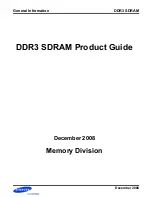
Thermal Management
64
Datasheet
bi-directional PROCHOT#. Platforms must not rely on software usage of this
mechanism to limit the processor temperature. On-Demand Mode can be done via
processor MSR or chipset I/O emulation.
On-Demand Mode may be used in conjunction with the Adaptive Thermal Monitor.
However, if the system software tries to enable On-Demand mode at the same time the
TCC is engaged, the factory configured duty cycle of the TCC will override the duty
cycle selected by the On-Demand mode. If the I/O based and MSR-based On-Demand
modes are in conflict, the duty cycle selected by the I/O emulation-based On-Demand
mode will take precedence over the MSR-based On-Demand Mode.
5.2.1.4.1
MSR Based On-Demand Mode
If Bit 4 of the IA32_CLOCK_MODULATION MSR is set to a 1, the processor will
immediately reduce its power consumption via modulation of the internal core clock,
independent of the processor temperature. The duty cycle of the clock modulation is
programmable via Bits 3:1 of the same IA32_CLOCK_MODULATION MSR. In this mode,
the duty cycle can be programmed from 12.5% on/87.5% off to 87.5% on/12.5% off in
12.5% increments. Thermal throttling using this method will modulate each processor
core’s clock independently.
5.2.1.4.2
I/O Emulation-Based On-Demand Mode
I/O emulation-based clock modulation provides legacy support for operating system
software that initiates clock modulation through I/O writes to ACPI defined processor
clock control registers on the chipset (PROC_CNT). Thermal throttling using this
method will modulate all processor cores simultaneously.
5.2.1.5
THERMTRIP# Signal
Regardless of enabling the automatic or on-demand modes, in the event of a
catastrophic cooling failure, the processor will automatically shut down when the silicon
has reached an elevated temperature that risks physical damage to the processor. At
this point the THERMTRIP# signal will go active. THERMTRIP# activation is independent
of processor activity and does not generate any bus cycles.
5.2.1.6
Critical Temperature Detection
Critical Temperature detection is performed by monitoring the processor temperature
and temperature gradient. This feature is intended for graceful shutdown before the
THERMTRIP# is activated. If the processor's Adaptive Thermal Monitor is triggered and
the temperature remains high, a critical temperature status and sticky bit are latched in
the thermal status MSR register and also generates a thermal interrupt if enabled. The
assertion of critical temperature bit indicates that processor can no longer be assumed
to be working reliably.For more details on the interrupt mechanism, refer to the
Intel®
64 and IA-32 Architectures Software Developer's Manuals.
















































